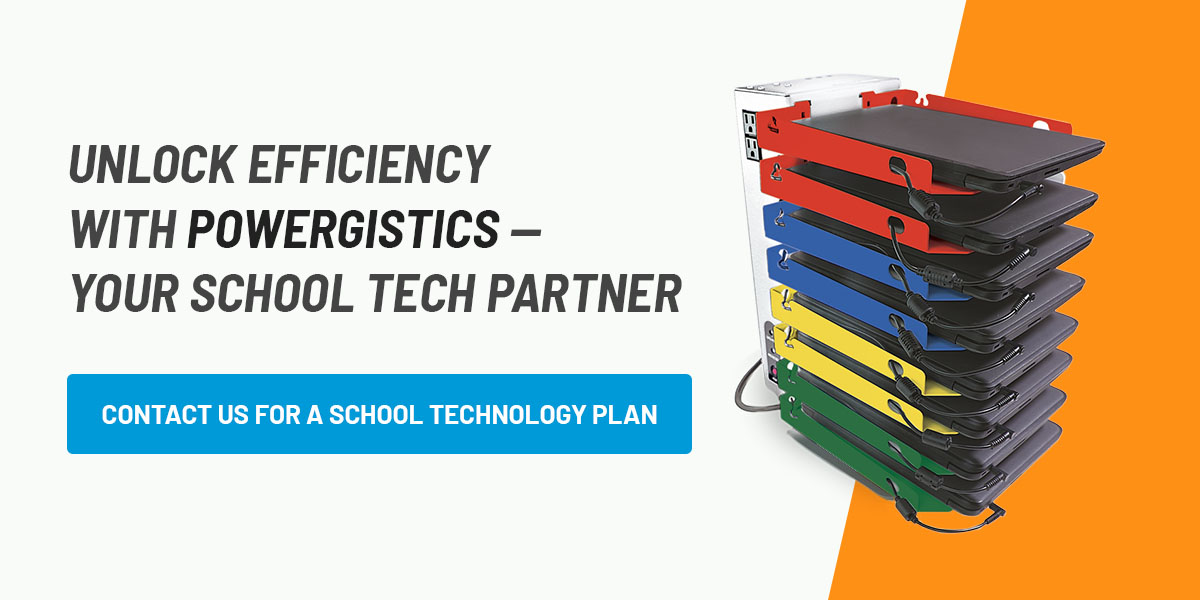Technology Plans for Schools
In education’s changing landscape, technology plans for schools are vital progress blueprints. These plans are more than mere paperwork but guiding frameworks that pave the way for a seamless future of learning. Thus, implementing technology in schools plays a pivotal role in enhancing learning environments.
As IT directors and managers, you understand the importance of a well-thought-out technology integration plan for your school. It’s the key to seamless technology adoption and maximizing the benefits of the digital age.
Below, we’ll delve into the intricacies of how the strategic use of a school technology plan can optimize educational outcomes.
What Is a Technology Plan?
A technology plan in the context of schools is a strategic roadmap that outlines how technology will be used to enhance education and achieve specific educational goals. It’s the compass guiding educational institutions into the digital age.
At its core, a technology integration plan for schools encompasses several crucial elements:
- Budgeting: It outlines the financial roadmap, ensuring that resources are allocated wisely to acquire, maintain and upgrade technology infrastructure.
- Research: Informed decisions drive success. A technology plan involves thorough research to identify the right tools, software and hardware that align with educational goals.
- Integration: Seamless technology integration into the curriculum is a key aspect. It focuses on how technology enhances teaching and learning, ensuring that it becomes an integral part of the educational process.
- Assessment: Regular evaluation is essential. A technology plan includes mechanisms for assessing the effectiveness of technology use, allowing for adjustments and improvements.
In essence, technology plans for schools are strategic tools that empower educators and IT leaders to make informed decisions, allocate resources efficiently and create a tech-savvy learning environment for students.
Why Is a Technology Plan Necessary?
In the evolving educational landscape, the shift from sporadic tech integration to a structured plan is paramount. Without a comprehensive strategy, schools face challenges that hinder progress.
The problem — schools lacking a technology plan often grapple with resource misallocation, fragmented tech adoption and inconsistent professional development. This hinders the realization of tech’s full potential in education.
The solution? Crafting a comprehensive technology plan for schools is the answer. It brings clarity, purpose and direction to tech initiatives — ensuring efficient resource utilization and strategic implementation of technology in schools. Moreover, it empowers educators with the tools and support needed for effective tech integration.
A well-thought-out plan is the cornerstone of successful tech integration. It transforms sporadic efforts into a structured, purpose-driven journey toward educational excellence through the use of a school technology plan.
10 Steps to Implementing Technology in Schools
Creating a successful technology implementation plan for schools requires a methodical approach. IT directors and managers play a crucial role in ensuring that technology enhances the learning experience. This 10-step guide will walk you through the process, from setting clear goals to assessing the impact of technology on education. We’ll explore each step in detail to help you craft a comprehensive and effective technology plan for your school.
Step 1 — Setting Clear Goals and Purpose
Start by defining your technology integration goals. Whether it’s improving teaching, streamlining administration or enhancing student engagement — clear objectives are essential. Setting a clear purpose provides direction and context for technology use in education, laying the foundation for a thriving implementation plan.
Consider your budget and explore how you can use your available resources to its maximum potential.
Step 2 — Conducting Comprehensive Research
The second step in crafting your technology plan for schools is conducting comprehensive research. Start by assessing your current technology resources and usage. Identify strengths and areas for improvement. Learn from successful schools and gather insights from faculty, students and staff through surveys. This research forms the foundation for informed decisions in your technology implementation plan.

Step 3 — Reviewing and Organizing Research
After conducting research, carefully assess the gathered data, including technology usage, faculty and student needs and best practices. Coalesce information from these varied sources to create a roadmap for informed decisions. Structured data organization sets the foundation for a strategic and impactful technology plan that caters to your school’s unique requirements.
Step 4 — Engaging With Stakeholders
Involve teachers, administrators, students and parents to get an understanding of their tech needs and concerns. This kind of collaboration identifies challenges and, when the time comes for implementation, ensures buy-in and promotes ownership. This step fosters inclusivity, aligns with financial capabilities and creates a comprehensive tech strategy.
Step 5 — Integrating into the Curriculum
You’ll also need to communicate why tech is in the curriculum. Clarify how it aligns with your goals and the educational experience. When everyone understands the “why,” tech becomes a valuable teaching tool, not a distraction. This step starts the transformation — making tech integral to education.
Step 6 — Selecting the Right Technology
When selecting your technology, ensure your choice aligns with the educators’ teaching methods and enhances student learning. Assess if tablets or laptops suit the needs of the school, students and curriculum. Tablets are versatile and great for all ages, while laptops, especially Chromebooks, are popular for research and assignments. Your budget will play a large role in the technology you choose to adopt.
Step 7 — Planning and Hiring Technical Support
A robust technical support system is the backbone of a successful technology plan in schools. As an IT director or manager, you need to have a team of experienced technicians for installation, monitoring and troubleshooting. Invest in storage and maintenance solutions like charging carts to keep devices in optimal condition. A well-supported tech infrastructure ensures a smooth learning experience and minimizes disruptions. This step provides tools and expertise for a seamless tech plan, enhancing teaching and learning.
Step 8 — Deploying the Technology
Deploying your technology involves a lot more than just handing out tablets and laptops. Your staff will need to check the devices, install any necessary programs and ensure the internet bandwidth can support the larger demand. It needs to be scheduled outside of class time, which might mean calling staff in a few days before the start of term. While costly and time-consuming, an effective deployment strategy can ensure everything goes smoothly.
Step 9 — Providing Professional Training
Faculty tech-savviness is key. Professional training ensures that teachers are confident in using new devices and software effectively. Offer comprehensive training covering hardware and software. Well-prepared teachers enhance teaching and engage students, improving outcomes and tech implementation. Invest in readiness for the digital learning landscape.
Step 10 — Monitoring Results and Continuous Assessment
After tech implementation, it’s crucial to assess its effect on teaching, learning, student engagement and faculty satisfaction. Regularly review and adapt to new tech and education needs. Stay connected with faculty and students for feedback on what’s working and what can be improved. Stay agile and responsive — creating a future-ready learning environment. Keep improving to empower students with the best technology.
The Role of IT Directors and Managers
In education, effective IT directors and managers are the architects of technology plans in schools. Their role is multi-faceted:
- Managing technical support: They ensure that the chosen technology functions well, evaluating devices, software and infrastructure and responding to challenges.
- Creating cohesion: Their task is to create a unified technology plan that serves a purpose in education.
- Faculty training: They empower educators with effective tech use through training and ongoing support.
- Adaptability: Staying updated on tech trends is vital, given the evolving landscape.
In essence, they shape a digital learning landscape that enriches teaching and engages students — preparing them for the future. Their dedication and expertise are key to the success of technology integration plans in schools.
Unlock Efficiency With PowerGistics — Your School Tech Partner
PowerGistics simplifies tech plans for schools. With our standout product, the PowerGistics TableTower8, we offer a streamlined approach to device management, organization and accessibility. Say goodbye to bulky carts and tangled cords and hello to efficiency, time savings and student empowerment.
PowerGistics products boost organization, safety and accessibility, aligning seamlessly with school tech plans for efficiency and productivity. Contact us online today for a future-ready school technology plan.
